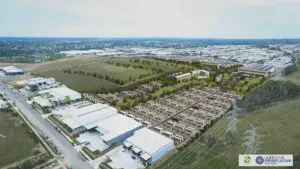Australia has around seven gigawatts of battery storage projects at various stages in the development pipeline, a new report has estimated, nearly 1GW of which is on track to be delivered by 2024.
Projections from Cornwall Insight Australia published on Thursday suggest there is currently just over 900MW-worth of committed or significantly progressed big battery projects being developed around the country with another 6GW-plus either proposed or in planning.
This is not altogether surprising. Australia did, after all, install the world’s first and biggest grid connected Tesla big battery at the Hornsdale wind farm in South Australia and ever since – as RenewEconomy editor Giles Parkinson wrote here – almost everyone “beyond the PM’s office and the government-owned Snowy Hydro” is taking the market very seriously.
Last month, the biggest big battery in Australia, the largest in the southern hemisphere was unveiled by the Victoria government, Tesla and developer Neoen, marking just the latest of more than a dozen big battery projects to be formally announced in the last few months, with many more in the pipeline.
Still, as the Cornwall Insight analysis points out, 7GW of battery storage is rather a lot – and certainly far more than forecast by the Australian Energy Market Operator. (And it does not include the proposed 20GWh battery to go with the Sun Cable project in the Northern Territory.
“Even if we only assume that 10% of the projected storage will make it to completed projects, that is still a total of ~1.5GW of battery storage that we can expect by 2024 – more than 13x AEMO’s forecast in the Integrated System Plan,” said principal consultant, Ben Cerini.
“The question then becomes, given the size of the storage pipeline and the recent commitment to deliver the largest battery in Australia of 300MW. Do we already need to re-evaluate the amount of storage projected to be built in the NEM?”
In the below graph, Cornwall Insights illustrates the difference between its battery storage projections for Australia and the Central Case scenario projected by the AEMO’s ISP, although it notes that since the graph was created, AGL has announced a further 200MW big battery project at its Loy Yang coal plant to be operational in 2023.
Cornwall also notes that the battery storage modelled by AEMO is based on grid reliability and not the battery storage being developed to provide other grid services and capitalise on other revenue streams.
As RE has noted, batteries have very quickly proven to be very versatile; able to perform multiple different functions, including increasing capacity on transmission links, providing emergency security response, frequency control, synthetic inertia, and also simply as a storage device, charging at times of low prices and discharging at times of peak demand, when prices usually rise.
“To be fair,” Cerini says, “[the ISP] doesn’t consider the ability of system services contracts to be able to underpin investment in battery storage that allows batteries to then compete in energy and ancillary service markets.
“But as we have seen, those that move quickly will be rewarded and be in the best possible position to take advantage of new revenue streams when (not if) they arrive.”
That said, AEMO has been criticised before for its lack of vision on battery storage. In 2016, then-ACT climate minister Simon Corbell slammed comments from the market operator that it would be 10-20 years until battery storage would have an influence on grid stability and support.
“It was a remarkably conservative and pessimistic view of a technology that is showing a trend of rapid cost falls,” Corbell said at the time. “And it highlights some of the challenges we face in the design of our energy markets when that sort of presentation is being made to decision makers at COAG level.”
The report finds that the state with the largest MW of proposed battery projects is Victoria, with more than 4GW in the planning and development pipeline – an amount that represents nearly half (more than 40%) of the state’s recent peak demand.
New South Wales, meanwhile, has a smaller 1.3GW in the pipeline, but Cornwall notes that this is “well on the way” to the 2.3GW identified in the state government’s NSW Roadmap.
“Our projections show that there is currently a strong pipeline for energy storage across the NEM, despite the challenging economics and the continually developing value streams, which can be volatile,” said Cerini.
“More battery storage will deliver more system and ancillary services while also assisting during peak demand. Underestimating the role of storage may have significant implications for future projects.”











